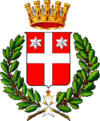Oderzo
| Oderzo | ||
|---|---|---|
| Comune | ||
| Comune di Oderzo | ||

Piazza Grande (Main Square).
|
||
|
||
| Location of Oderzo in Italy | ||
| Coordinates: 45°46′48″N 12°29′17″E / 45.78000°N 12.48806°E | ||
| Country | Italy | |
| Region | Veneto | |
| Province / Metropolitan city | Treviso (TV) | |
| Frazioni | Camino, Colfrancui, Faè, Fratta, Rustignè, Piavon | |
| Government | ||
| • Mayor | Maria Scardellato | |
| Area | ||
| • Total | 42 km2 (16 sq mi) | |
| Elevation | 14 m (46 ft) | |
| Population (1 January 2015) | ||
| • Total | 20,413 | |
| • Density | 490/km2 (1,300/sq mi) | |
| Demonym(s) | Opitergini | |
| Time zone | CET (UTC+1) | |
| • Summer (DST) | CEST (UTC+2) | |
| Postal code | 31046 | |
| Dialing code | 0422 | |
| Patron saint | San Tiziano | |
| Saint day | 16 January | |
| Website | Official website | |
Oderzo (Latin: Opitergium; Venetian: Oderso) is a town and comune in the province of Treviso, Veneto, northern Italy. It lies in the heart of the Venetian plain, about 66 kilometres (41 miles) to the northeast of Venice. Oderzo is traversed by the Monticano River, a tributary of the Livenza.
The centro storico, or town center, is rich with archeological ruins which give insight into Oderzo's history as a notable crossroad in the Roman Empire.
The six suburbs or frazioni which surround Oderzo almost in the form of a hexagon. Starting from the north and then proceeding clockwise, they are:
The earliest settlement of the area can be dated to the Iron Age, around the 10th century BC. From the mid-9th century BC the Veneti occupied site and gave it its name. Etymologically, "-terg-" in Opitergium stems from a Venetic root word indicating a market (q.v. Tergeste, the old name of Trieste). The location of Oderzo on the Venetian plain and between the Monticano and Navisego rivers made it ideal as a center for trade.
The Veneti of Oderzo appear to have maintained friendly relations with the Romans and the population was gradually Romanized after the Romans moved into the area around 200 BC. The town was granted Latin rights in 182 BC. The Via Postumia, finished in 148 BC, passing through Oderzo, connected Genua to Aquileia, and thus, increased the importance of Oderzo.
Citizens of Oderzo likely were involved in the Social War in 89 BC since acorn-like missiles with names in Venetic and Latin inscriptions have been found at Ascoli Piceno.
...
Wikipedia


